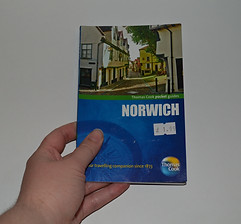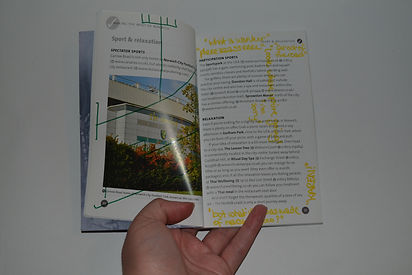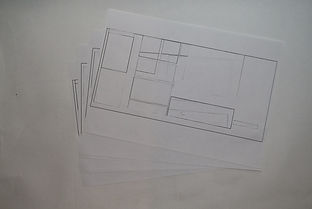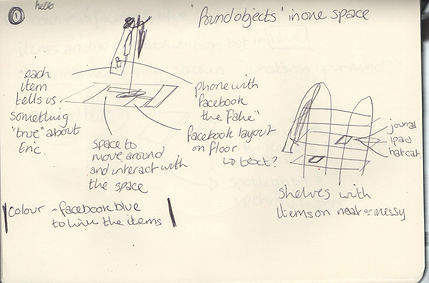Ampersand
"What's on your mind?"
During the first meeting with my UEA partner, Bonnie, we bonded over the idea of having an unreliable character. We are both interested in creating deception with our work, and the ease of which it is possible on social media.
I began looking at unreliable narrators within films and programmes and landed on the TV series Mr Robot and its main character Eliot. He is delusional, with anxiety and paranoia issues, which led to many narrative threads questioning how believable he is as our narrator. Often he does not tell us all the facts because he doesn’t know them himself. However through the great writing and strong acting we are made to believe he has a tight grip on everything in the situation.
Eliot has many moments of awkward social interactions where time seems to slow down. Either this is real, or is another figment of his mind. I have been observing, and drawing in time with these pauses, to explore the expression shown through the gesture and facial expression.
Can these drawn-out moments of expression lead us to understand if the situation or emotion of the scene is real? If I believe this is reliable information, can I represent that within the sketches? Is there a screen based difference between the truth and fiction?
 |  |
|---|---|
 |  |
 |  |
 |  |
 |  |
 |
Accompanying the series is a book, Red Wheelbarrow: (eps1.91_redwheelbarr0w.txt); a journal which follows Eliot through a long period of hallucination. The journal has added notes in the margins written by another character, which acts as the truth in the otherwise dishonest story. There is a great juxtaposition here between the fake and the real, in which the false outweighs everything. This echoes the second series in which we do not find out the truth until the last episode.
Mr Robot
Deception
During another short meeting with Bonnie, we decided to use Facebook as our lens to explore the concept of deception, and the control needed to create it. Could we create an unreliable narrator through Facebook? Essentially I believe all information, all ‘friends’ on Facebook are unreliable. It is a system on which we are forced to only put good information, or material that leads to some form of attention. It is the highlights of our lives with only the best parts on show. Is it possible to create a persona through this format of only positive highlights?
The idea of having parts of a life readily obtainable led me to think of parts of conversations overheard in the street. Often I query what the context for the phrase is and begin to make a story of my own. And this is often the same case with gesticulations.
Rawle's collage
We recently had a lecture by Graham Rawle, exploring his work of collaged images and text. I wondered if it were possible to echo this through overheard quotes. Rawle spent years collecting and ordering lines from 50s magazines and books, making his outcomes make perfect stories. I wander if random elements from observations could echo this pattern to create a character? Could any sense be made from such random text?
Quotes
I began collecting overheard phrases from around Norwich. As I am using observational research I decided the character would be best to be from Norwich. Briefly speaking with Bonnie we decided to both collate quotes over a week, and she could use these to attempt to form a text.
Could random phrases from observations could echo this pattern to create a character?
Could any sense be made from such random text?


Sketches


I naturally began sketching whilst observing people, especially elements that went with the overheard phrases. As I continued to envisage stories, the drawings seemed to become more abstract; my imagination led the lines astray. I hope to use the abstract within the process, as Eric will be an elusive character, it is fitting the imagery is too.


 |  |  |
|---|---|---|
 |  |  |
 |  |  |
 |  |  |
 |  |  |
 |
Personality
Bonnie and I also brainstormed names in this meeting. I came up with the thought of using the ‘Voice of Norwich’ or ‘Norwich Speaks’ as an anagram to create a name. After a few try’s we found our character’s name; Eric Pawn-Shosk.
The next task was creating Eric’s personality. Unfortunately, Bonnie had little idea how to create a rounded character. However I spoke to several people across courses and gathered research into how you build a character. A games art student told me you need to explore and understand the reason of the individual. They are placed within the game for a purpose. Whereas a student of film said, over his three years of experience, he had learnt that wants and fears were the main elements you need to understand to create a rounded character.
Bearing these traits in mind I questioned the idea of the thin line between truth and fiction. Eric’s fear could be of people finding out who he ‘really’ is, rather than a polished personality he portrays on Facebook.
“A good work of art can never be read in one way. My work is full of contradictions. An artwork is open—it is the spectators looking at the work who make the piece, using their own background.”
-Christian Boltansky
Boltansky’s work relies heavily on the person viewing its’ understanding. He lays out the elements and allows the audience to make their own interpretation. He is the curator to the piece, and carefully chooses every element. This is a concept I’d like to replicate through ‘Eric’. If just the right items are chosen, or placed on Facebook in a certain order, the viewer can decide about his truthful personality for themselves.
Facebook as a canvas
Whilst I still had no text from Bonnie, and as I carried on with observational drawings, I began dissecting Facebook as a canvas. I looked at the interface as a whole, exploring hierarchy through the buttons, emojis and status’. The status’ are texts that ‘friends’ have published and can be commented on or liked. And they are the one of the quickest changing parts of the page. The text last’s 5 minutes maximum, and are often littered with adverts. If I could make the adverts relate to Eric, perhaps this would make for a more convincing profile?
There are layers and layers of information on the homepage, which is almost overwhelming. Every bit of information is unique, but ever changing; if you blink you may miss it. I think this echoes overhearing a part of a sentence or conversation, which you hear and dismiss almost instantly.
The status bar asks, ‘What’s on your mind?’, which is where I got the titles for the project.
 |  |
|---|---|
 |

I cut out the shapes in each of the 16 Facebook layouts, as though highlighting the areas of interest. With these I took a series of photographs, exploring the use of light and shadows. The warping of the shapes echos the warping of his reality.
 |  |
|---|---|
 |  |
 |  |  |
|---|---|---|
 |  |  |
 |  |  |
Eric's wants and fears
I still hadn’t had any work from Bonnie, therefore I took it upon myself to create a personality for Eric. He fears people finding out his true emotions and wellbeing, and hides behind facebook. He wants to be seen as the perfect person; a vague, intriguing character. The non-representational text and image will echo his persona.
Could a series of objects, for example, tell
us something truthful about Eric as a man?
But does this abstract being need context?
After speaking my ideas through with my reader group, I realised Eric's personality is based on the fake, but how do we know he is fake if we have nothing to compare it to. I need a 'real' persona to go with the 'fake.
The truth through objects
Elmgreen and Dragsets exhibition, Tomorrow, explores the use of objects on a mass scale to provoke a reaction in the viewer. They handpicked hundreds of items to create a narrative through an apartment of a fictional architect. The objects are curated, and I’m sure everyone has a reason for being in the installation, however this is not obvious but implied. Elmgreen and Dragsets exhibition, Tomorrow, explores the use of objects on a mass scale to provoke a reaction in the viewer. They handpicked hundreds of items to create a narrative through an apartment of a fictional architect. The objects are curated, and I’m sure everyone has a reason for being in the installation, however this is not obvious but implied.
One thought I had about the concept of the 'real' versus 'fake' personality was to create found objects.
If I create a similarity throughout all the objects, could I literally scatter them throughout the exhibition? Imagine finding his jacket, with the guide book in, on the back of a sofa. Or the tablet on the bar, with the Facebook page open. I think this could echo the ‘found’ research that creates the status’ and the layers of images.




I was getting worried around this time, as I still hadn't had any writing or any communication with Bonnie. Was she collecting quotes? Writing Facebook status? Or just leaving me to it?
I decided to just carry on without any idea if I were to get any of her writing. As I had come up with the idea of using overheard quotes, I'd built myself a back up plan. I could create the status' if I needed to.
I was panicking that I had no real idea what I was doing and at this point it was less than two weeks before the exhibition. I thought i'd be luck if i'd have anything to show in the Ampersand show. Luckily I shared these thoughts with a few different people, and all of them told me to just carry on! I think I was lacking confidence in my work, and had not hear anything back from Bonnie since we'd come up with the concept together.
I carried on regardless and began brainstorming ways I could represent the 'true' side to Eric. I came to two options; through objects, or through a journal. With hindsight I feel the objects could have made for a really hopeful outcome, that would question the audience's understanding of the character. It could have been an exciting experience to watch people interact with the objects in order to find the clues I had left.
As it stood I took a safe choice and produced a journal which held the inner thoughts and markings of Eric. I used personal accounts as a reference within these pages, as well as incorporating the quotes and some observational drawings. I regret making this decision, however I felt I had very little time left, and I wasn't sure if I'd ever get any work from Bonnie. I had to come up with something that I could show, even if I didn't have her work.
Outcome Development
Looking at my choices I really wanted to include the exact RGB colouring of Facebook, so I made this the cover of the journal. I also had another acetate layer, a physical layer to represent the layer of the screen shielding us from the truths of social media.
I designed and made two covers exactly the same, so from the outside it was difficult to tell which account was the journal, and which was a casing with an ipad inside, with the Facebook page on. Essentially which was the real Eric and which is the fake.
I also chose and altered one of the Facebook layout's I had previously worked on so I could put it on the top of the table. I was debating whether to use acrylic paint, however I found electrical tape to be very useful for creating quick, near perfect lines. Given more time I would have perfected these lines, exactly as they are on Facebook. However I believe the small table still represented the shapes well. And created a situational context for the books to sit in.
I wanted to stick to the colours of Facebook, the grey, blue and white. Looking back at it I could have painted the table in-keeping with this colour scheme. Or perhaps it worked as neutral territory for both the books.


Thinking about the design of the piece I really wanted a computer desk to sit the journals on. Unfortunately I did not have one to use, so I had to use a coffee table instead. I felt the layout of the table had to be much like the Facebook interface, strict and hierarchical.
Images
As I still didn't have any text to work from I made some images from the previous drawings and photographs I had made. I wanted to explore with layering the shapes until they become so abstract they are barely recognisable. This echos my feeling towards filters on many social media sites, how worrisome it is when the person is hardly identifiable.
Many of the quotes had a slightly dark or twisted feeling to them, and so it felt appropriate to represent this feeling through the images.
 |  |  |
|---|---|---|
 |  |  |
 |  |  |
Status'
As I was in the process of making the ipad holder, the journal and creating the images I wasn't feeling good about the work. I think I was worrying too much about the time, and not having heard anything from Bonnie. I put too much pressure on having something good for the show, and not on the work itself.
I used observational drawing as my main tool, as I enjoy it. Even though I usually use it as a means of research not as a final work, I believe the layering of the drawings with photographs represents the natural hand, complementing the soft edges of the lighting. I have used influences from the quotes, so I only hope they fit with the status' if or when I get them.
A couple of days before the exhibition set up Bonnie messaged me with some status'. By now I already had some of my own, however I decided to use hers. None of the text was coherent, the quotes made sure of that. So the abstract status' matched the abstract images to create a mystery around Eric. Where the journal revealed some truths about him as a person.
In order to create a lighter side to Eric I had given him an interest; hats. But it was a subtle theme. Several of the hand movements are people touching their hats. However Bonnie didn't understand when I explained the word subtlety and so the concept was lost. This resulting in many of the status' talking about hats, which was not my intention.
"I vaguely recall
Seeing them in Castle mall
On the top left corner
They created an aura
Around them,
Drawing me in
Like sirens they would sing
I could never resist
The call that continuously persists
The call of the hat."
"It was in the dying light of the market place,
That I saw her face,
Standing there,
For not a care
In the world
Could stop her wearing such a gold,
Majestic, hat.
It was there that I fell in love,
With the exquisite taste of all that is above,
One’s head.
For as Keith Sutherland said
To anyone standing there pigeon-toed:
Get out if the road!"
"As I tripped and tumbled towards the playhouse,
The cobbled streets made me skip a beat.
As I tripped and tumbled there,
The smell of bacon filled the air,
As I tripped and tumbled there.
I love bacon.
As I tripped and tumbled over the bridge
I couldn’t resist the smell,
Oh well,
I’ll go to the playhouse another day.
As I trip and tumble towards Greggs
I can smell burning Teddy bear,
It has put me off the bacon."
Example Status'
Exhibition Setup
There were mixed messages when it came to me getting a table in the show, so I told a member of the curation team i'd supply my own. Unfortunately when I turned up to Dove Street Studios there was a table ready and waiting for me.
This was only a problem because I has designed tape layers in the form of Facebook on the top of my table. Luckily that evening I was able to design another Facebook inspired layout.

Final outcome
Left: Original small table design
Below: New design for larger table



Once I had received the poems from Bonnie, I started to upload them to the Facebook page with my images. The page was not looking how i'd hoped. The Facebook layout is a very bare one, and the images suddenly became cold in these surroundings. Without meaning to I think I made a negative, sad impression, instead of a mysterious one as I had hoped.
The confusing text that went with them I think helped to create a curious tone to the page. One think Bonnie and I decided to try and ease the awkwardness and create a full character, was to include links and references to other aspects of his life. For example a quote from Matt Haig's, The Humans. A book referencing an alien coming into our world and trying to fit in. Having the plain Facebook image, that everyone without a profile picture has, is marker of a strange profile, and one you are often warned to stay away from.
It was my decision to lay the two journals next to one another, so that when one is open you can only see one 'personality' to Eric. There is a fake and a real side, but you may never see both at the same time.
During the exhibition this was noticed and seen as layers of one persons thoughts and being.


Ampersand Exhibition



As I was setting up the tape and books I was unimpressed with the outcome. The colours of the tables didn't match, that tape wasn't perfect and non of the first hand research I had conducted was visible. The Facebook page and journal weren't having the juxtaposing effect i'd hoped.
It was then that I decided I had to include the booklets that I had created for research. The small table had a perfect shelve that was now torso height, perfect to put enticing little booklets for people to flick through.
I'm so glad I did add the smaller items to the display as they got a far better reaction at the exhibition night. The Facebook layouts with elements cut through stood out for many people. They became something that was recognisable, but only a few people could place it. Out of everything they created the most questions and interest, and the layers were clear. The simple shapes here worked well, something I may experiment with further.
Perhaps with more time and confidence I would have laser cut the layout out of some clear perspex and layered them to create a feeling of hollowness found in Eric's journal. Or perhaps used them at a greater size, with some lighting to create shadows in a space in which people could walk around. Their shadows becoming the 'empty' friends of Eric.
Overall I am unhappy with this project, and annoyed with myself that I didn't take the concept into my own hands. Perhaps given more time I would have been able to turn the work around into something I could be proud of. I've learnt I always need a starting point, in this case I thought it would be the writing, however missing it I felt lost and without a subject. Through every tutorial I have not felt any belief in this work and I should have used that feeling to go back, think about it again and essentially go back to the early stages of concept. I needed to question what I was truly trying to say? A question I will take on with me into the next phase of my work.
During the last week or so I have been attempting to get out of a negative mindset by starting a new project with Emma DeCruz.
